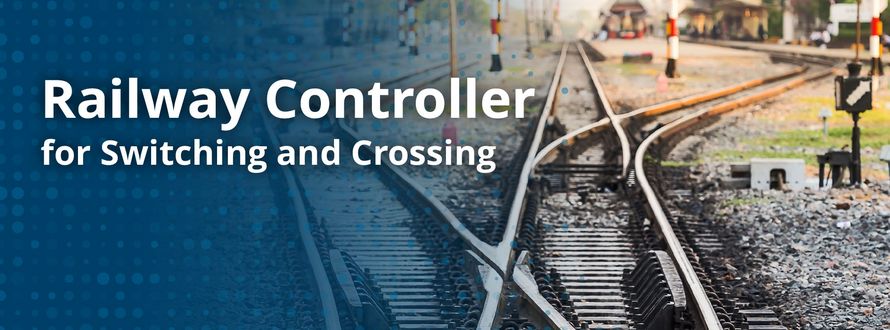Railway signalling systems are the backbone of safe and efficient train operations, especially as rail networks expand in complexity and traffic density. Among the most critical components of these systems are the controllers that manage switches and crossings—the devices that physically move rails to guide trains from one track to another. Given the high risk associated with failures in such systems, their control units must adhere to the highest safety standards.
One such standard is Safety Integrity Level 4 (SIL 4), as defined by the IEC 61508 and EN 50128 / EN 50657 standards used in railway applications. SIL 4 represents the highest level of safety integrity, with a probability of dangerous failure per hour (PFH) of less than 10⁻⁸. This article explores the use of SIL 4 railway controllers in switching and crossing systems, detailing their applications, technology stack, and the future of these critical safety systems.
Use Cases and functional Scope
Switches and crossings (also known as turnouts and frogs) enable trains to change tracks at junctions, crossovers, and diverging points. These components are essential in:
- Railway junctions where tracks intersect
- Marshalling yards where trains are reconfigured
- Mainline diverging tracks allowing routing flexibility
- Urban and light rail networks where high frequency requires fast and safe switching
- Maintenance bypasses for redirecting traffic during track repair
In all these cases, precise and safe operation of switches and crossings is non-negotiable. A failure here could lead to derailments, collisions, or service disruptions. The SIL 4 controller ensures:
- Safe actuation of switch machines (electromechanically or hydraulic)
- Verification of position using redundant sensors and feedback loops
- Fail-safe fallback modes in case of component malfunction
- Interlocking integration with central signalling systems
- Remote health monitoring and diagnostics
SIL 4 systems are particularly vital in high-speed rail and dense metro networks, where even a minor error can have catastrophic consequences due to the speed and frequency of operations.
Technology Architecture
A SIL 4 railway controller integrates hardware redundancy, software verification, and communication fail-safes to meet the stringent safety requirements. Below are the key technological aspects:
1. Hardware Redundancy and Diversity
- Dual Modular Redundancy (DMR) or Triple Modular Redundancy (TMR) is often used to ensure continuous operation even if one processor fails
- Diverse processing units (e.g., ARM + FPGA or x86 + microcontroller) are employed to detect systematic faults that could affect similar architectures
- Redundant sensors and actuators, such as dual-point detectors and motor drives, provide cross-verification of switch positions
2. Fail-Safe Logic and Watchdog Mechanisms
- SIL 4 controllers implement watchdog timers and diverse logic paths to detect and mitigate faults in real time
- Controllers revert to safe states—usually locking or isolating the switch—when anomalies are detected
- All outputs are fail-safe relays with normally de-energized (open) states to ensure safety in power loss scenarios
3. Safety-Certified Real-Time Operating System (RTOS)
- The controller operates on an RTOS certified for SIL 4, such as SYSGO's PikeOS
- The RTOS ensures deterministic behavior, memory isolation, and task scheduling required for safety-critical applications
4. Formal Verification and Software Design
- Software is developed using model-based design (MBD) and verified through formal methods, which mathematically prove correctness
- Languages like SCADE, Ada, or SPARK are preferred due to their determinism and support for certification
- The software must pass extensive unit, integration, and system-level testing, including fault injection and long-term reliability simulations
5. Communication Interfaces
- Controllers interface with signalling systems via redundant serial protocols (e.g., RS-485 with CRC checks) or safe Ethernet using certification-compliant channels
- Advanced systems use IP-based protocols like ETB (Ethernet Train Backbone) or Safe Secure Communication Protocols (SSCP) with cryptographic integrity checks
- Support for remote diagnostics and predictive maintenance through integration with asset management platforms
Safety Lifecycle and Certification
To be certified as SIL 4, the entire life cycle of the controller—from concept to retirement—must follow rigorous development and validation under the EN 50126 (RAMS), EN 50128 (software), and EN 50129 (hardware safety) standards.
- Hazard and Risk Analysis (HARA) identifies and categorizes risks
- Failure Modes and Effects Analysis (FMEA) and Fault Tree Analysis (FTA) ensure robustness against all foreseeable failures
- Certification is typically conducted by third-party agencies such as TÜV Rheinland, DNV, or Lloyd’s Register
Conclusion and Future Outlook
SIL 4 railway controllers for switching and crossing represent the pinnacle of safety in modern railway signalling. These controllers combine advanced embedded technology, formal safety engineering, and real-time performance to ensure that the most critical movements on the track happen without error.
As rail systems become increasingly digital, the next evolution of SIL 4 controllers is already underway. Edge computing, AI-assisted diagnostics, and cybersecurity hardening are emerging trends. Future systems will also support remote software updates, digital twins for predictive maintenance, and standardized interfaces for plug-and-play deployment across multiple rail networks.
In the context of Autonomous Train Operations (ATO) and European Rail Traffic Management System (ERTMS) levels 3 and 4, the reliability of SIL 4 controllers will be even more critical. As signalling systems evolve towards greater automation and interoperability, SIL 4 technology will remain a foundational component—ensuring that safety keeps pace with innovation.

